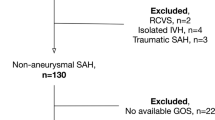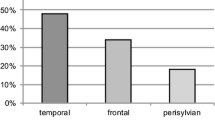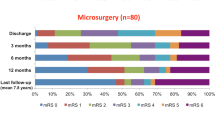Abstract
Introduction
Superficial siderosis is presumably a consequence of recurrent bleeding into the subarachnoid space. The objective of this study was to assess the prevalence of superficial siderosis after singular, aneurysmal subarachnoid hemorrhage (SAH) in the long term.
Methods
We retrospectively identified all patients who presented with a singular, acute, aneurysmal SAH at our institution between 2010 and 2013 and in whom a magnetic resonance imaging (MRI) including T2*-weighted imaging was available at least 4 months after the acute bleeding event. MRI scans were judged concerning the presence and distribution of superficial siderosis. Influence of clinical data, Fisher grade, localization, and cause of SAH as well as the impact of neurosurgical interventions on the occurrence of superficial siderosis was tested.
Results
Seventy-two patients with a total of 117 MRIs were included. Mean delay between SAH and the last available MRI was 47.4 months (range 4–129). SAH was Fisher grade 1 in 2 cases, 2 in 4 cases, 3 in 10 cases, and 4 in 56 cases. Superficial siderosis was detected in 39 patients (54.2 %). In all patients with more than one MRI scan, localization and distribution of superficial siderosis did not change over time. Older age (p = 0.02) and higher degree of SAH (p = 0.03) were significantly associated with the development of superficial siderosis.
Conclusion
Superficial siderosis develops in approximately half of patients after singular, aneurysmal SAH and might be more common in patients with an older age and a greater amount of blood. However, additional factors must play a role in whether a patient is prone to develop superficial siderosis or not.


Similar content being viewed by others
References
Bracchi M, Savoiardo M, Triulzi F, Daniele D, Grisoli M, Bradac GB, Agostinis C, Pelucchetti D, Scotti G (1993) Superficial siderosis of the CNS: MR diagnosis and clinical findings. AJNR Am J Neuroradiol 14(1):227–236
Kumar N (2010) Neuroimaging in superficial siderosis: an in-depth look. AJNR Am J Neuroradiol 31(1):5–14. doi:10.3174/ajnr.A1628
Linn J, Herms J, Dichgans M, Bruckmann H, Fesl G, Freilinger T, Wiesmann M (2008) Subarachnoid hemosiderosis and superficial cortical hemosiderosis in cerebral amyloid angiopathy. AJNR Am J Neuroradiol 29(1):184–186. doi:10.3174/ajnr.A0783
Linn J, Halpin A, Demaerel P, Ruhland J, Giese AD, Dichgans M, van Buchem MA, Bruckmann H, Greenberg SM (2010) Prevalence of superficial siderosis in patients with cerebral amyloid angiopathy. Neurology 74(17):1346–1350. doi:10.1212/WNL.0b013e3181dad605
Charidimou A, Peeters A, Fox Z, Gregoire SM, Vandermeeren Y, Laloux P, Jager HR, Baron JC, Werring DJ (2012) Spectrum of transient focal neurological episodes in cerebral amyloid angiopathy: multicentre magnetic resonance imaging cohort study and meta-analysis. Stroke J Cereb Circ 43(9):2324–2330. doi:10.1161/strokeaha.112.657759
Zonneveld HI, Goos JD, Wattjes MP, Prins ND, Scheltens P, van der Flier WM, Kuijer JP, Muller M, Barkhof F (2014) Prevalence of cortical superficial siderosis in a memory clinic population. Neurology. doi:10.1212/WNL.0000000000000150
Iwanowski L, Olszewski J (1960) The effects of subarachnoid injections of iron-containing substances on the central nervous system. J Neuropathol Exp Neurol 19:433–448
Fisher CM, Kistler JP, Davis JM (1980) Relation of cerebral vasospasm to subarachnoid hemorrhage visualized by computerized tomographic scanning. Neurosurgery 6(1):1–9
Teasdale GM, Drake CG, Hunt W, Kassell N, Sano K, Pertuiset B, De Villiers JC (1988) A universal subarachnoid hemorrhage scale: report of a committee of the World Federation of Neurosurgical Societies. J Neurol Neurosurg Psychiatry 51(11):1457
Inoue T, Takada S, Shimizu H, Niizuma K, Fujimura M, Sato K, Endo H, Tominaga T (2013) Signal changes on T2*-weighted magnetic resonance imaging from the acute to chronic phases in patients with subarachnoid hemorrhage. Cerebrovasc Dis 36(5–6):421–429. doi:10.1159/000355897
Takada S, Inoue T, Niizuma K, Shimizu H, Tominaga T (2011) Hemosiderin detected by T2*-weighted magnetic resonance imaging in patients with unruptured cerebral aneurysms: indication of previous bleeding? Neurol Med Chir 51(4):275–281
Imaizumi T, Chiba M, Honma T, Niwa J (2003) Detection of hemosiderin deposition by T2*-weighted MRI after subarachnoid hemorrhage. Stroke J Cereb Circ 34(7):1693–1698. doi:10.1161/01.STR.0000075771.88719.CE
Kumar A, Aggarwal S, Willinsky R, TerBrugge KG (1993) Posterior fossa surgery: an unusual cause of superficial siderosis. Neurosurgery 32(3):455–457, discussion 457
Miliaras G, Bostantjopoulou S, Argyropoulou M, Kyritsis A, Polyzoidis K (2006) Superficial siderosis of the CNS: report of three cases and review of the literature. Clin Neurol Neurosurg 108(5):499–502. doi:10.1016/j.clineuro.2005.01.014
Vernooij MW, Ikram MA, Hofman A, Krestin GP, Breteler MM, van der Lugt A (2009) Superficial siderosis in the general population. Neurology 73(3):202–205. doi:10.1212/WNL.0b013e3181ae7c5e
Atlas SW, Mark AS, Grossman RI, Gomori JM (1988) Intracranial hemorrhage: gradient-echo MR imaging at 1.5 T. Comparison with spin-echo imaging and clinical applications. Radiology 168(3):803–807. doi:10.1148/radiology.168.3.3406410
Wollenweber FA, Buerger K, Mueller C, Ertl-Wagner B, Malik R, Dichgans M, Linn J, Opherk C (2014) Prevalence of cortical superficial siderosis in patients with cognitive impairment. J Neurol 261(2):277–282. doi:10.1007/s00415-013-7181-y
Ethical standards and patient consent
We declare that the study was approved by our Institutional Review Board and has therefore been performed in accordance with the ethical standards laid down in the 1964 Declaration of Helsinki and its later amendments. We declare that all patients gave informed consent prior to inclusion in this study.
Conflict of interest
We declare that we have no conflict of interest.
Author information
Authors and Affiliations
Corresponding author
Rights and permissions
About this article
Cite this article
Lummel, N., Bernau, C., Thon, N. et al. Prevalence of superficial siderosis following singular, acute aneurysmal subarachnoid hemorrhage. Neuroradiology 57, 349–356 (2015). https://doi.org/10.1007/s00234-014-1480-6
Received:
Accepted:
Published:
Issue Date:
DOI: https://doi.org/10.1007/s00234-014-1480-6




